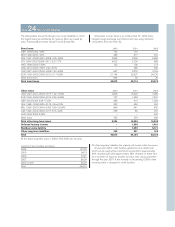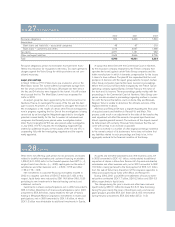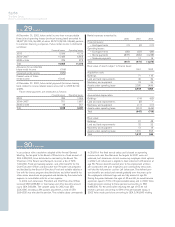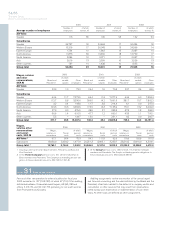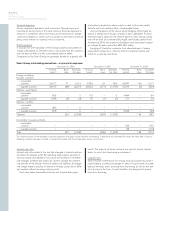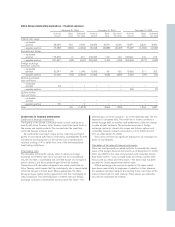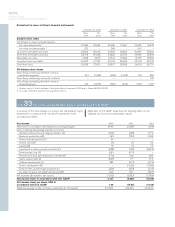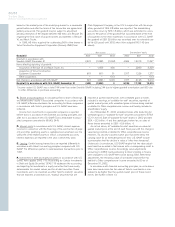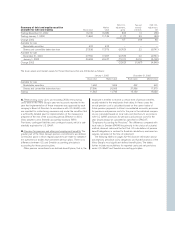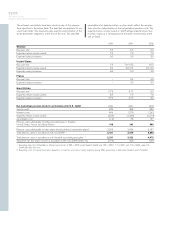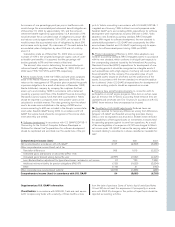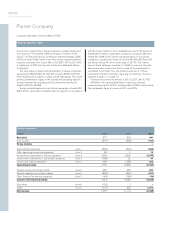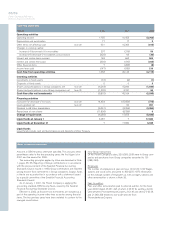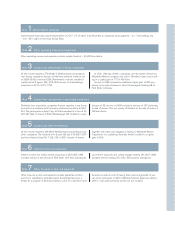Volvo 2002 Annual Report Download - page 61
Download and view the complete annual report
Please find page 61 of the 2002 Volvo annual report below. You can navigate through the pages in the report by either clicking on the pages listed below, or by using the keyword search tool below to find specific information within the annual report.
Shareholders’ equity 2000 2001 2002
Shareholders’ equity in accordance with Swedish accounting principles 88,338 85,185 78,278
Items increasing (decreasing) reported shareholders’ equity
Derivative instruments and hedging activities (A) (1,286) (1,584) 188
Business combinations (B) 1,317 4,125 5,219
Shares and participations (C) 36 36 36
Interest costs (D) 112 130 152
Leasing (E) (163) (149) (134)
Investments in debt and equity securities (F) (6,066) (7,328) (9,813)
Restructuring costs (G) 579 – –
Pensions and other postemployment benefits (H) 109 272 (20)
Alecta surplus funds (I) (523) (412) (2)
Software development (J) 754 542 330
Product development (K) – (1,962) (3,263)
Entrance fees, aircraft engine programs (L) (387) (719) (855)
Tax effect of above U.S. GAAP adjustments (M) 1,941 3,155 1,066
Net increase (decrease) in shareholders’ equity (3,577) (3,894) (7,096)
Shareholders’ equity in accordance with U.S. GAAP 84,761 81,291 71,182
Net income Shareholders' equity
Accounting for derivative instruments and hedging activities 2000 2001 12002 2000 2001 12002
Derivatives Commercial exposure (654) 342 1,814 (1,286) (944) 870
Derivatives Financial exposure – (685) 43 – (685) (642)
Derivatives in fair value hedges 808 426 – 808 1,234
Fair value adjustment hedged items – (765) (511) – (763) (1,274)
Transition adjustment – 2––––
Derivative instruments and hedging activities in accordance
with U.S GAAP, December 31 (654) (298) 1,772 (1,286) (1,584) 188
1The Volvo Group's Net income and Shareholders' Equity in accordance with U.S. GAAP in 2001 have been restated in the financial statements for 2002, due to
a calculation error in the 2001 numbers.
B. Business combinations. Acquisitions of certain subsidiaries are
reported differently in accordance with Volvo’s accounting principles
and U.S. GAAP. The difference is attributable primarily to reporting
and amortization of goodwill.
Effective in 2002, Volvo has adopted SFAS 141 “Business
Combinations” and SFAS 142 “Goodwill and Other Intangible Assets”
in its determination of Net income and Shareholders’ equity in accord-
ance with U.S. GAAP. In accordance with the transition rules of SFAS
142, Volvo has identified its reporting units and determined the car-
rying value and fair value of each reporting unit as of January 1,
2002. No impairment loss has been recognized as a result of the
transitional goodwill evaluation. In Volvo’s income statement for 2002
prepared in accordance with Swedish GAAP, amortization of goodwill
charged to income was 1,094. In accordance with SFAS 142, good-
will and other intangible assets with indefinite useful lives should not
be amortized but rather evaluated for impairment annually.
Accordingly, the amortization of goodwill reported under Swedish
GAAP has been reversed in the determination of Net income and
Shareholders’ equity under U.S. GAAP. Furthermore, impairment tests
have been performed for existing goodwill as of December 31, 2002.
No impairment loss has been recognized as a result of these tests.
In 2001, AB Volvo acquired 100% of the shares in Renault V.I.
and Mack Trucks Inc. from Renault SA in exchange for 15% of the
shares in AB Volvo. Under Swedish GAAP, the goodwill attributable
to this acquisition was set at SEK 8.4 billion while under U.S. GAAP
the corresponding goodwill was set at SEK 11.5 billion. The differ-
ence was mainly attributable to determination of the purchase con-
sideration. In accordance with Swedish GAAP, when a subsidiary is
acquired through the issue of own shares, the purchase consider-
ation is determined to be based on the market price of the issued
shares at the time of the transaction is completed. In accordance
with U.S. GAAP, such a purchase consideration is determined to be
Significant differences between Swedish and U.S. account-
ing principles
A. Derivative instruments and hedging activities. Volvo uses forward
exchange contracts and currency options to hedge the value of
future commercial flows of payments in foreign currency and com-
modity purchases. Outstanding contracts that are highly certain to be
covered by forecasted transactions are not assigned a value in the
consolidated accounts.
Under U.S. GAAP hedge accounting is not applied for commercial
derivatives, and therefore outstanding forward contracts and options
are valued at market rates. The profits and losses that thereby arise
are included when calculating income. Unrealized net gains for
2002 pertaining to forwards and options contracts are estimated at
870 (losses 944; losses 1,286).
Volvo uses derivative instruments to hedge the value of the
Groups’ financial position. In accordance with U.S. GAAP, all out-
standing derivative instruments are valued at fair value. The profits
and losses that thereby arise are included when calculating income.
Only part of the Groups’ hedges of financial exposure qualify for
hedge accounting under U.S. GAAP and are accounted for as such.
In those cases the hedged items are valued at fair value regarding
the risk and period beeing hedged and included when calculating
income.


